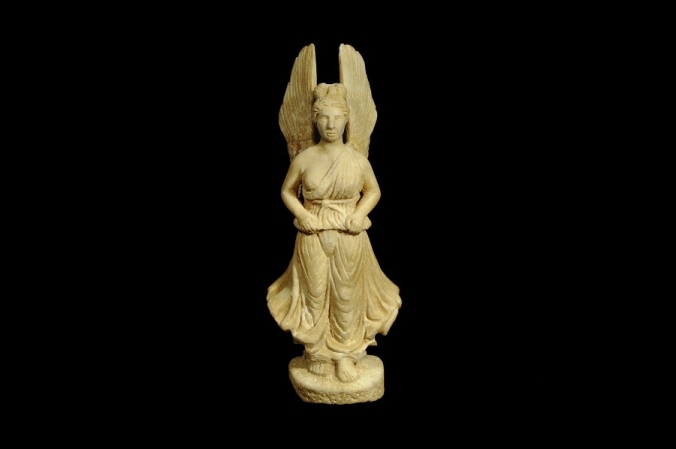Roman Marble Statuette (Idol) of Greek goddess Nike

Baidun Fine Antiquities – Since 1927 – http://www.Baidun.com
FEATURED ITEM: Roman Marble Statuette (Idol) of Greek goddess Nike
This Roman Marble Statuette (Idol) of Greek goddess Nike (as of 07 / April / 2017) is still available for sale from http://www.Baidun.com:
Reference: SI_RM_1060
Civilization: Roman, 200 C.E.
Size: H. 21.5 cm
Condition: Tips of the wings and neck rejoined, otherwise in fine condition
Price: Available upon request
Provenance: The Baidun Collection
DIRECT WEB SITE LINK: http://baidun.com/roman-marble-statuette-idol-of-greek-goddess-nike/
SHORT URL: http://www.goo.gl/4rmCKp
Roman Marble Statuette (Idol) of Greek goddess Nike
Nike – The Greek goddess of Victory
Nike was a Greek war goddess who personified victory. Her Roman equivalent was Victoria. The Greek goddess Nike was variously described as the daughter of the Titan Pallas and the goddess Styx, and the sister of Kratos (Strength), Bia (Force), and Zelus (Zeal).
Nike is seen with wings in most statues and paintings, with one of the most famous being the Winged Victory of Samothrace (also known as “The Winged Nike“). Most other winged deities in the Greek pantheon had shed their wings by Classical times. Nike is the goddess of strength, speed, and victory. Nike is also one of the most commonly portrayed figures on Greek coins.
Equivalents in the Mesopotamian (Sumerian / Akkadian) Pantheons
The Greek goddess Nike is most likely a Greek adaptation of the Babylonian/Assyrian goddess Ištar (Ishtar), the Mesopotamian East Semitic (Akkadian (Assyrian and Babylonian)) goddess of fertility, love, war, sex, and power. She is the counterpart to the earlier attested Sumerian Inanna who was the goddess of love, beauty, sexual desire, fertility, knowledge, wisdom, war, and combat. She was one of the most widely venerated deities in the ancient Sumerian pantheon. Ishtar is the cognate for the later attested Northwest Semitic (Aramean/Canaanite) goddess Astarte (Ashtoreth),* as well as the Armenian goddess Astghik. Ishtar was an important deity in Mesopotamian religion which was extant from c. 3500 BCE, until its gradual decline between the 1st and 5th centuries CE with the spread of Christianity.
Equivalents in the Egyptian Pantheon
Among equivalents to- or influences upon- the Greek goddess Nike from the Egyptian pantheon, there are several candidates who are described as goddesses of war (in various capacities). They are 1.) Bastet; 2.) Menhit; 3.) Neith; and 4.) Sekhmet. The uniting of Egyptian cultures of Upper and Lower Egypt had also united deities that shared similar roles and usually the same imagery. In Upper Egypt, Sekhmet was the parallel warrior lioness deity. Often similar deities merged into one with the unification, but that did not occur with these deities having such strong roots in their cultures. Instead, these goddesses began to diverge.
These Egyptian goddesses of war are: 1.) Bastet, who was the goddess of warfare in Lower Egypt, the Nile River delta region before the unification of the cultures of ancient Egypt; 2.) Menhit, whose name depicts a warrior status, as it means “(she who) massacres”; 3.) Neith, goddess of war and of hunting; and 4.) Sekhmet (or Sachmis – also spelled Sakhmet, Sekhet, or Sakhet, among other spellings, means “the powerful one”) is a warrior goddess as well as goddess of healing.
The Egyptian war goddess Neith ~ Nike
The Egyptian war goddess Neith (also spelled Nit, Net, or Neit) provides an interesting example. There are possible (probable) linguistic similarities of the name Nike (pronounced “Ni-ke” or “Ni-kay”; “Nee-ke” or “Nee-kay”) with the name Neith (pronounced “Nith” or “Neeth”; “Nit” or “Neet”).
Roman Marble Statuette (Idol) of Greek goddess Nike
For the ancient Greeks – among their pantheon of gods and goddesses – the Greek goddess Nike (in the anthropomorphized form of a young, winged woman) personified victory in war. In this outstanding example of ancient Greco-Roman art, the Nike portrayed here is represented standing here on a base with an inclined surface (perhaps on the summit of a hilltop or “high place” of worship) with her wings unfolded and outstretched upright towards the heavens. She is dressed in a peplos fastened at her shoulder and tied with a cord just below her bosom.
The young woman’s pose, the movement of the peplos, and the position of the wings may indicate that she has just alighted on the ground. The Nike portrayed here is standing in an upright position (almost at attention) while a strong wind blows from directly in front of her, therefore causing her peplos to cling against the front of her body (as well as lift the dress from behind as wind will do).
Upon first glance, the rendering of the face may seem a bit impersonal and idealized (indeed her traits recall several portraits of Faustine the Elder, the wife of Antoninus Pius). The large folds of her peplos are reminiscent of the sculptures in the local style of the Levant (Syria and Jordan), whence this piece probably originated.
Roman Marble Statuette (Idol) of Greek goddess Nike
SHORT URL: http://www.goo.gl/4rmCKp
Baidun Fine Antiquities
Jerusalem
http://www.Baidun.com
http://www.TheBaidunShop.com
http://www.BaidunFineAntiquities.com
FOLLOW US ON FACEBOOK:
https://www.facebook.com/BaidunFineAntiquities/
FOLLOW US ON INSTAGRAM:
https://www.instagram.com/baidunfineantiquities/
FOLLOW US ON FLICKR:
https://www.flickr.com/people/148463208@N08/
FOLLOW US ON WORDPRESS:
https://baidun.wordpress.com
FOLLOW US ON TWITTER:
FOLLOW US ON TUMBLR:
http://baidunfineantiquities.tumblr.com/
FOLLOW US ON GOOGLE+ PLUS:
https://plus.google.com/106715984037897740713
FOLLOW US ON LINKED IN:
https://il.linkedin.com/in/baidun-fine-antiquities-7aa4b5130
FOLLOW US ON ABOUT.ME:
https://about.me/baidunfineantiquities
FOLLOW US ON MEDIUM:
View at Medium.com